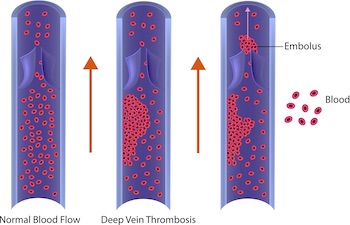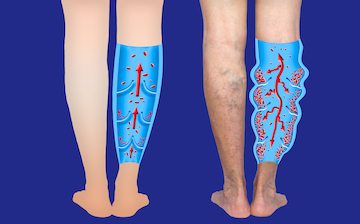Deep Venous Thrombosis
Deep venous thrombosis occurs when a clot forms in one of the big veins in the body, usually in the lower leg, thigh, or pelvic veins. Once the clots are established in the vein, it can block blood flow back to the heart. This can cause pain and swelling of the lower extremities. Clots can also break away and go to the heart and the lungs, causing significant damage to the lungs or even death. This is called pulmonary embolism, which occurs in 300,000 patients annually in the United States. Pulmonary embolisms are responsible for more deaths than AIDS, breast cancer, and all car accidents combined. Deep venous thrombosis surgery is often required in severe cases to remove these life-threatening clots and restore proper blood flow.
Deep Vein Thrombosis Surgeon
If a DVT is not treated early with an early thrombectomy and the blood clot stays in the vein for a prolonged period, it can damage the delicate one-way valves in the veins, which can cause chronic venous insufficiency. This would carry a lifelong disability with swelling of the leg, pain, and ulcerations. Consulting a deep vein thrombosis surgeon for early intervention is crucial to prevent such severe complications.


Deep Venous Thrombosis Doctor
If you have any of these symptoms or other concerning health conditions, you should consult a deep venous thrombosis doctor immediately.
Risk factors for DVT include
- Sitting down with the legs crossed for prolonged period airplane travel.
- History of surgery, especially knee or hip surgery.
- Cancer.
- Pregnancy.
- Advanced age.
- Genetic diseases and inherited clotting disorders called thrombophilias.
- Infection.
- Obesity.
- Immobility.
- Fracture of the leg bones.
Deep vein thrombosis symptoms
These include leg swelling, pain, warmth, redness, and decreased sensation. Unfortunately, deep venous thromboses are silent and often have minimal symptoms. Diagnosis of DVT can easily be diagnosed with an ultrasound, which is a noninvasive test that can be done in the office. Deep vein thrombosis treatment is usually initiated to prevent complications when a diagnosis is confirmed.
DVT Symptoms
Treating proximal DVTs early enough to save the delicate one-way valve in the veins and prevent chronic venous insufficiency is very important. This can be done with minimally invasive procedures that remove clots with mechanical thrombectomy and chemical thrombolysis. During these procedures, a small needle is inserted into the vein. Subsequently, thrombolytic medicines are injected into the clot to dissolve the clot. Mechanical thrombectomy devices are then used to remove the clot. This allows the patient to have normal flow in the veins, and, more importantly, it prevents damage to the delicate valves in the veins, preventing long-term disability associated with chronic venous stasis. A medical professional or vein clinic in Los Angeles, CA, should only do this treatment.
Patients are also treated with long-term anticoagulation that prevents blood clots from propagation of blood clots to the heart and the lung, causing pulmonary embolism, which can have severe consequences such as pulmonary disability and death. Deep vein thrombosis treatment can significantly improve outcomes and help patients regain their health.
In cases where the blood clot is very extensive or patients cannot tolerate blood thinners, a filter can be inserted into the vena cava to prevent the clot from reaching the lungs and causing a fatal pulmonary embolism. These filters are removable and can be removed when the clot has resolved. Consulting with a deep venous thrombosis doctor or surgeon is essential to determine the need for filters and other advanced deep venous thrombosis treatments. Contact Encino Vascular at +1 818-908-9752 or book an appointment to consult with one of our expert deep venous thrombosis doctors.
DVT Stories
At Encino surgical Institute we can diagnose DVTs, place and remove inferior vena cava filters and perform DVT thrombectomies.
Proudly accepting patients in